How does a text change from one iteration to the next? Different editions of a printed work – even under the same title – often conceal significant differences between them. Authors, in the early modern period as today, changed their work as they were invited to produce different editions; translators, in turn, frequently did far more than just translate, often arrogating to themselves an authorial role that accommodated their own personal views. The lack of intellectual copyright in this period allowed editors and publishers to adapt texts in order to sell their wares. In search of the perfect way to take a book to market, they changed formats, illustrations and intended audiences.
Drawing on Randall McLeod’s notion of “transformission” – which implies that texts were transformed from the moment they were transmitted – this exhibition follows several of the most celebrated texts related to the early modern Americas as they made their way from inaugural to subsequent editions. New Worlds were transformed and transmitted to new audiences sometimes beyond recognition. Ultimately, these cases of radical transformission raise the question: when does a text stop being the “original” text and start to become something else?
The genre fluidity of Mundus novus
The Florentine banker Amerigo Vespucci (1451- 1512) participated in two or three early Atlantic voyages for the Spanish and Portuguese crowns. After returning from an expedition to the coast of Brazil (1501-1502), he sent a letter from Lisbon to his friend and former employer Lorenzo di Pierfrancesco de’ Medici (1463–1503). In this letter, now lost, Vespucci identified the newly found territories as a New World, rather than the outer limits of the Old World (Asia).
Vespucci’s vivid style and the focus on scenes of sexual liberty and cannibalism made the Medici letter an immediate international bestseller. Through dozens of editions in various languages that appeared in a few years’ time, the letter was transformed in different directions. On one extreme, Vespucci’s report was quickly elevated in status by the addition of a new title highlighting the discovery, Mundus novus. On the other extreme, the letter was decontextualized and fictionalized as an episode of the medieval “wonders of the East” tradition.
Alberic[us] Vespucci[us] Laure[n]tio Petri Francisci de Medicis salutem plurima[m] dicit. Paris: Felix Baligault & Jehan Lambert, [1503].
The Paris edition is traditionally considered to be the earliest surviving version of Vespucci’s report (1503). It was probably translated from the original Italian manuscript by Giovanni Giocondo of Verona (c. 1445 – c. 1525), the royal architect to the French king.
The publication is still clearly marketed as a letter, with Vespucci’s salutation to his friend Pierfrancesco de’ Medici on the first page serving as a title. The rest of the page is filled by the elaborate printer’s device of Felix Baligault and Jehan Lambert, a combination of separate woodblocks and typography.

Amerigo Vespucci, Mundus novus, Rome: Eucharius Silber, [1504]. / Amerigo Vespucci, Mundus novus. Augsburg: Johannes Otmar, 1504.
Eucharius Silber in Rome and Johannes Otmar in Augsburg chose a different marketing strategy for Vespucci’s account. The text is still recognizable as a letter, with the salutation in a larger font and separated from the main text block.
However, the addition of a clearly distinct title – Mundus novus – powerfully shifts the text’s focus to Vespucci’s claim to have discovered a new continent. Johannes Otmar even separated the title from the text, creating a captivating half-title page.
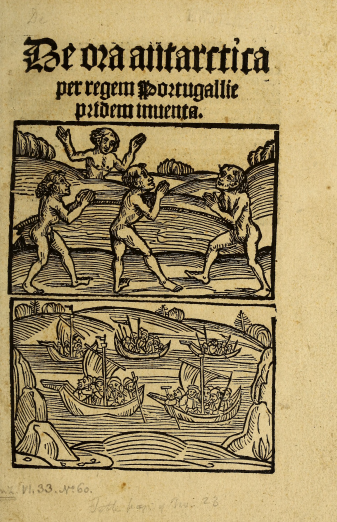
De ora antarctica per regem Portugallie pridem inuenta. Strassburg: Mathias Hupfuff, 1505.
This 1505 Augsburg edition adds additional paratext to the letter, making it less ephemeral, more attractive, and more prestigious. This edition is the first to show New World imagery on the title page: a group of naked (dancing) Natives and a scene of five ships with men in Oriental clothing. The editor of the text, the Alsatian humanist Matthias Ringmann, added an introductory epistle and a poem relating to the newly encountered lands as preliminaries. Ringmann also changed the title to the more learned-sounding “On the Antarctic coast recently discovered by the king of Portugal.” Based on the work of Ptolemy and Virgil, he was convinced that the lands described by Vespucci were located “almost under the Antarctic pole.”
The title did not catch on in later editions, but Ringmann’s work had the result of bringing together a group of scholars who decided to update the work of Ptolemy, resulting in the 1507 world map where the fourth continent was named America.
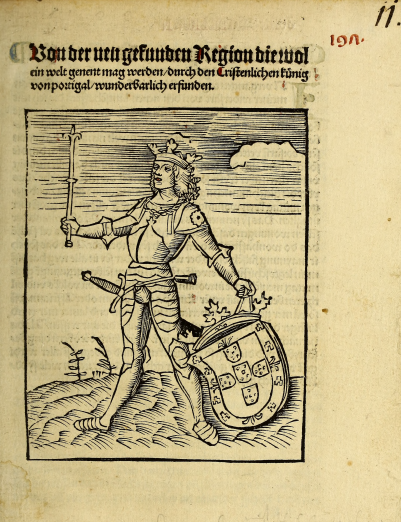
Amerigo Vespucci, Von der neü gefunden Region so wol ein Welt. [Nuremberg : W. Huber, 1506].
The original manuscript letter (now lost) was written in Italian and subsequently translated into Latin for the first printed editions. Less than two years later, publishers in Basel, Nuremberg and Augsburg popularised the text by providing a German translation (1505). Translations in other languages soon followed: Italian (1505), Czech (1505), Dutch (1509), and French (1517).
Included in the Mundus novus letter are a number of simple scientific illustrations. One of them represents the spatial relationship of Europe vis-à-vis the new world in the shape of a triangle, whose legs mark their relative locations of the two continents: “da sind wir” (we are here) and “da sind sie” (they are there). This model triangulates the geographical location of the inhabitants of Lisbon compared to those of Brazil, taking into account the shape of the world.
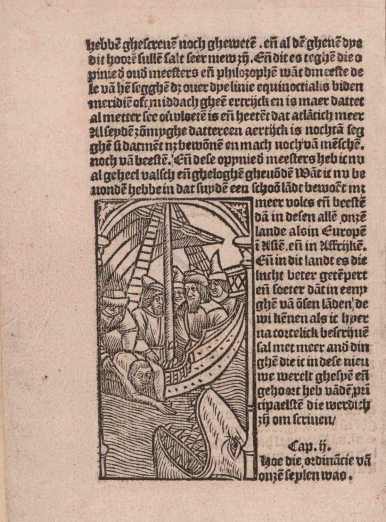
Amerigo Vespucci, Van der nieuwer werelt oft landtscap. Antwerp: Jan van Doesborch, [1509-].
This Dutch adaptation of the letter survives in only one copy and was printed by the Antwerp publisher Jan van Doesborch, who built his success on illustrated romances and other popular genres in the vernacular. Van Doesborch seems to have judged the letter of Vespucci to be a perfect fit for his publisher’s list and transformed it into a chapbook. The story is divided into chapters and is illustrated with six woodcuts of mostly naked Natives. The print omits Vespucci’s last name, and hints that “Alberic, the best pilot in the world”, may have been an inhabitant of the Low Countries serving the Portuguese king.
Especially captivating is how Van Doesborch added another layer to the “Vespucci triangle”. The addition of illustrated scenes on the legs of the triangle changes the drawing’s original geographical meaning into a cultural one. The 90-degree angle in which the group of noble Europeans touch the naked Americans can be interpreted as symbolizing both cultural differences and encounter.

Balthasar Springer, Die reyse va[n] Lissebone. Antwerp: Jan van Doesborch, 1508. / C.H. Coote, The Voyage from Lisbon to India 1505-6 being an account and journal by Albericus Vespuccius. London: B. F. Stevens, 1894.
In the Journey to Lisbon, Van Doesborch decontextualizes Vespucci even further, to the point of transforming him into a fictional character or a generic European explorer. The publisher merges the journey of his main character, Alberic, with the German traveler Balthasar Springer’s trip to India, part of the 1505 mission of the Portuguese Francisco de Almeida. The earliest surviving printed account of Springer’s travels dates from 1509.
This rare edition puzzled a number of nineteenth-century scholars and collectors, who believed for some time that the work actually described an unknown voyage of Vespucci to the East.
The many readings of the Brevísima relación
The Brevísima relación de la destrucción de las Indias is an account written by the Dominican friar Bartolomé de las Casas (1484–1566), who condemned the mistreatment of the indigenous peoples of the Spanish Americas. Originally a slaveowner himself, Las Casas had been speaking out against the use of enslaved Native Americans – called Indians in his account – since 1515. The Brevísima relación was written in 1542 in order to convince the crown that conversion and colonization were best achieved by peaceful means. The text was only published ten years later, when Las Casas was well into his seventies.
Far from a bestseller, the Brevísima relación found a new life more than two decades after its original publication, when Protestant factions in the Spanish Netherlands used the text as a way to connect the atrocities of the Spanish armies in the Low Countries to Spanish atrocities in the Americas. From that moment on, the Brevísima relación became the go-to text for political enemies of Spain, identifying the Spanish throughout the centuries as the cruel oppressors and likening Spain’s enemies to the abused Natives.
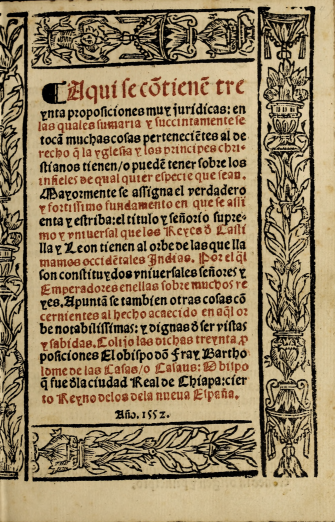
Bartolomé de las Casas, Breuissima relacion de la destruycion de las Indias. Sevilla: Sebastian Trugillo, 1552.
At the end of his life, Las Casas returned to Europe and retired from his duties as bishop of Chiapas, spending his remaining years writing and securing his legacy. Between 1552 and 1553, he engaged some of Seville’s best printers to print his treatises.
The Brevísima relación was written ten years before as an eye-witness account in a legal case to convince the emperor to reform the 1513 Laws of Burgos: to suppress the forced labor and involuntary conversion of the indigenous people. Although his pleas were initially successful and resulted in the New Laws of 1542, they were later watered down due to violent protests by Spanish landowners.
Since Las Casas wanted a new group of American missionaries to take the treatises with them, he did not want to wait until he had the required license. This however allowed his opponents to denounce him to the Inquisition, resulting in the text being seized and banned.
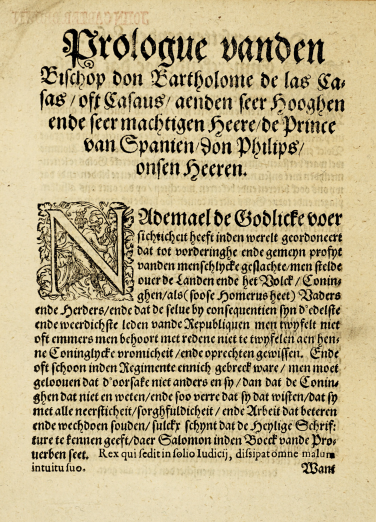
Bartolomé de las Casas, Seer cort verhael vande destructie van d’Indien. Antwerp, 1578.
The first re-edition and translation of the Brevísima relación (and three other treatises) happened in a completely different political setting. Since 1566, a civil war had broken out in the Low Countries between Netherlandish protestants who demanded religious freedom and Spanish governors, who increasingly responded with violence to these demands. In 1576, a mutiny amongst Spanish troops resulted in the plundering of several cities in the Low Countries, killing thousands of civilians and resulting in the open rejection of Spanish authority.
This anonymously published translation is faithful to the work of Las Casas. It keeps the original title, and adds only a one-page introduction from the translator, who avoids openly connecting the situation in the Indies to the Netherlands.
Bartolomé de las Casas, Tyrannies et cruautez des Espagnols, perpetrees és Indes Occidentales. Antwerp: Franciscus Raphelengius, 1579.
One year after the Dutch translation, a French translation was made by the Flemish protestant minister Johannes van Miggrode (1531–1627). Miggrode remarks that he was about a third of the way through translating the Brevísima into Dutch when he discovered that a Dutch translation had just appeared. Consequently, he decided to avoid doing double work and produced a French version instead.
The paratext of this edition clearly aims for a different message. The title of the work is changed to Tyrannies et cruautez des Espagnols (“Tyrannies and cruelties of the Spanish”) and further down on the title page Miggrode clearly expresses that the work should be seen as a “warning to the XVII Provinces of the Low Countries.”
Bartolomé de las Casas, Narratio regionum indicarum per Hispanos. Frankfurt: Theodor de Bry & Joannes Saurius, [1598].
The goldsmith-turned-engraver-and-publisher Theodor de Bry (1528–1598) became a Protestant in 1570 and lived in England and the Low Countries before settling in Frankfurt in 1588. His firm reached international acclaim with the production of a multi-volume, multi-lingual series of lavishly illustrated travel narratives.
In the last year of his life, De Bry published a Latin edition of Las Casas, with 17 engravings visualizing the most cruel passages from the text. Tormented, mutilated and murdered Amerindians are represented as Christian martyrs. De Bry’s version was published in the context of a war of images between Protestants and Catholics.
De Bry’s visualisation of Las Casas has to be read as a warning of the atrocities that Spaniards could inflict against Protestant nations.

Bartolomé de las Casas, Le miroir de la tyrannie espagnole perpetree aux Indes Occidentales. Amsterdam: Ian Evertss. Cloppenburg, 1620.
The images of De Bry’s Las Casas were very popular in Protestant Europe and were even sold without Las Casas’s text, especially in the newly established Dutch Republic. The Dutch- and French-language editions, illustrated with engravings based on De Bry, were printed nineteen times in the seventeenth century. By using the title The Mirror of the Spanish Tyranny, the editions emphasized the impact of the images and at the same time made explicit the reference to the present war between the Dutch and the Spanish.
Bartolomé de las Casas, Las obras. Barcelona: Antonio Lacavalleria, 1646.
There was only one Spanish edition of Las Casas’s work in the seventeenth century, comprising five of his treatises, and including the Brevísima. The original titles were changed in three of them, adding “por los Castellanos” or “los Reyes de Castilla.” In doing this, the edition emphasized that the term Castilian had to be read in the narrow sense, and not to to be understood as Spanish.
It was printed at the request of the vicar general of the diocese of Barcelona, in the middle of the conflict between the Spanish Crown and the short lived Catalan Republic (1641-1652). The independent republic was supported by France and the conflict was part of the broader Franco-Spanish war (1635–1659). The violent repression of the revolt in several Catalan towns inspired the regional reinterpretation of Las Casas work: the Castilians, not the other Spanish regions, were responsible for the atrocities in the Indies.
Bartolomé de las Casas, The Tears of the Indians. London: J.C. for Nath. Brook, 1656.
Las Casas’s work received - yet again - a new title in this new English translation: The Tears of the Indians. The title was possibly inspired by The Teares of Ireland (1642), a work describing the cruelties inflicted on Protestants in Ireland during the Irish Rebellion of 1641.
The translator John Phillips (1631–1706), a nephew of John Milton, dedicated the work to Oliver Cromwell (1599–1658), who had become head of state as the Lord Protector of the Commonwealth (1653). Phillips hoped that the work would inspire his countrymen to put an end to the civil war and reunite all Englishmen against their real enemy, the “Popish” Spaniards.
The cruelties of the Spaniards in the Indies were also used as a justification for English claims in the West Indies. It was the divine mission of the Lord Protector to avenge the tears of the Indians and chase the Spanish out of the Americas.
Bartolomé de las Casas, Breve relacion de la destruccion de las Indias occidentales, [Mexico]: Impresa en Sevilla, reimpresa en Lóndres, en Filadelfia y en México, en la oficina de don Mariano
In the midst of the Latin American wars of independence, Las Casas was re-edited many times and for the first time in the Americas: Bogotá (1813), Puebla (1821), Philadelphia (1821), Guadalajara (1822) and Mexico City (1822). The editor José Servando Teresa de Mier (1765–1827) was a priest and important supporter of Mexican independence.
In the Mexican edition’s preliminary discourse, Servando Teresa de Mier proclaimed Las Casas to be the prophet of American liberty and called for a statue of him to be erected as soon as independence was reached. From Mier’s perspective, the Creoles – that is, American-born descendants of Spanish colonists – had become the American Natives, who needed protection from Spanish colonial power.
Marketing and Formatting The History of the Americas
A humanist priest with close ties to the conquistador Hernán Cortés, Francisco López de Gómara (1511–1564) was one of the first historians of the Americas who described the “discovery” of the New World as the greatest event in world history since the birth of Christ. He constructed his chronicle as a heroic tale, culminating in the the achievements of Cortés, whom he glorified as a contemporary Alexander the Great. This bias explains the clear division of the text: La (h)istoria de las Indias and Conquista de Mexico (1552).
In 1553, the Council of the Indies banned the text from being published. Nevertheless, the ban was not immediately effective in Spain, since later editions appeared in in Zaragoza and Medina del Campo in 1553, 1554 and 1555. Also in Antwerp, the thriving port city at the Northern end of the Spanish empire, an emerging group of printers aiming to break into Iberian markets took an interest in López de Gómara’s work (1553 and 1554). Driven by commercial rather than political interests, the Antwerp printers immediately launched the text as a pocket edition. In trying to convince the buyer of the quality of their edition, printers played an “edition game” that held the middle between imitation and emulation.

Francisco López de Gómara, La istoria de las Indias. y Conquista de Mexico. Zaragoza: Agustin Millan, 1552.
López de Gómara’s work was published at the end of 1552 by Agustín Millán in Zaragoza (active from 1551 to 1564). The coat of arms of Charles V dominates the title page. There is almost no space for the actual title: La istoria [!] de las Indias is followed on the next line by “y conquista de Mexico.”
Published five years after the death of Cortés, there is no mention of him or the author on the title page. In an unusual introduction, López de Gómara directly addresses the readers, translators and publishers, claiming to have a privilege for ten years.
Francisco López de Gómara, Primera y secunda parte de la Historia general de las Indias. Medina del Campo: Guillermo de Millis, 1553.
It is unclear if the edition of Guillermo de Millis – published only a couple of months later – was approved by López de Gómara. However, since the paragraph mentioning the privilege is omitted here, it seems unlikely.
Although clearly inspired by the Zaragoza edition, De Millis introduced a number of changes to make his edition more appealing. First of all, the title page was printed in two colors and in the more modern roman typeface (compared to blackletter in the 1552 edition). Secondly, De Millis tried to appeal to a Spanish rather than a Habsburg audience, by changing the coat of arms to that of Spain and by adding “Hispania victrix” in large letters at the top. Lastly, he changed the title by dividing the text in two equal parts and enlarged the title to make it more engaging.

Francisco López de Gómara, Primera y segunda parte de la Historia general de las Indias, Zaragoza: Miguel Zapila, 1553.
The answer from Zaragoza to the Medina del Campo imprint was immediate. Miguel de Suelves (or Zapila), one of Zaragoza’s most prolific printers and probably a co-investor in the production of the text together with Millan, issued a new title page for the original 1552 edition, clearly aimed as an answer and warning to Millis in Medina del Campo.
He kept the Habsburg coat of arms and the blackletter typeface from 1552, but copied the longer title from Millis and introduced red ink to the title page. Finally, he emphasized that this was the authorised edition by moving the vague reference to the privilege from the introduction to the title page.
Francisco López de Gómara, Chronica general delas Indias. / Antwerp: Joannes Bellerus, 1554. / Antwerp: Joannes Steelsius, 1554. / Antwerp: Martinus Nutius, 1554.
Less than two years after the first edition in Zaragoza, two different 1554 editions appeared involving no less than four different Antwerp printers. One the one hand, there was the edition by Joannes Nutius, with a local privilege. On the other hand, there was the édition partagée of publishers Joannes Steelsius and Joannes Bellerus, printed by Joannes de Laet. The latter tried to surpass Nutius’s original edition by advertising (on the title page) the elaborate geographical index they had added.
A typical character of the early Antwerp re-editions of Spanish bestsellers was the smaller and more economical formats in comparison to the Spanish printers. In the case of Historia general de las Indias the Antwerp editions used 40% less paper, reducing not only material but also labor costs.
Lost in Translation: Exquemelin’s pirates
A small 1678 volume in Dutch became an international bestseller by 1700, going through more than a dozen editions in five languages. The reason: the book offered an eyewitness account of the lives and adventures of some of the most notorious buccaneers. Alexandre Olivier Exquemelin (born in Honfleur in 1645) entered the service of the French West India Company and went to Tortuga as a servant, where he remained for three years before becoming a buccaneer. For the rest of his life, Exquemelin alternated short stays in Europe with travels to the West Indies, often serving (again) as a buccaneer. He continued to add new adventures to his original work, but the genre that he created soon took on a life of its own. His original critical tone was muffled in the English translation, and the addition of stories of other buccaneers – and buccaneering traditions – spurred the birth of pirate fiction.
Alexandre Olivier Exquemelin, De Americaensche zee-roovers. Amsterdam: Jan ten Hoorn, 1678
When Exquemelin sailed back from the Caribbean in 1674, he went to the Netherlands to study medicine. During his time there, he published his eyewitness account on the heyday of buccaneering, before returning to the Americas many times as both a surgeon and a buccaneer. The work is very critical of the behavior of the privateers or buccaneers, and uses the word zee-roovers (sea robbers) to describe the French and English seamen attacking the Spanish territories.
The work contains twelve engravings showing the fearless-looking leaders of the different bands, combined with scenes of violence, torture and plunder.
Eduward Meltons, Engelsch edelmans, zeldzaame en gedenkwaardige zee- en land-reizen. Amsterdam: Jan ten Hoorn, 1681.
This curious set of travel narratives was published by Exquemelin’s printer Van Hoorn under the pseudonym of Edward Melton, who supposedly travelled to Egypt, New Netherland, the West Indies and Asia. However, Melton seems to have been an invention of the publisher, who used existing travel narratives from Johann Michael Wansleben (1677), Adriaen van der Donck (1655) and Arnoldus Montanus (1671) to create the fictional journey attributed to Melton.
The account of the West Indies is in part taken from Exquemelin’s De Americaensche Zee-Roovers (1678), and allowed Van Hoorn to reuse some of the impressive plates that were made for this work.
Alexandre Olivier Exquemelin, Piratas de la America. Cologne: Lorenzo Struickman [= Amsterdam: David de Castro Tartas], 1681.
In 1681, Exquemelin’s account was published in a mysterious, Spanish language edition with the fictitious imprint: Cologne, by Lorenzo Struickman. The real printer, however, was David de Castro Tartas, a Portuguese Jew from Amsterdam. Exquemelin was introduced to the community through the translator of this edition, the Sefardic Alonso de Bonne-Maison or Buena-Maison. Both men studied medicine in Leiden and shared a house in Amsterdam.
The plates in this edition are altered versions of the same plates used by Van Hoorn in 1678, so they must have been borrowed or bought for the creation of this work.
The use of the imprint Cologne, a Catholic city, made it possible to sell the work without suspicion in the Catholic world.
Alexandre Olivier Exquemelin, Bucaniers of America. London: William Crooke, 1684.
Exquemelin had painted an often grim and critical picture of the dealings of the French and English buccaneers. He was especially critical of Henry Morgan’s attack on Panama (1669) and accused him of stealing from his men. In the first English translation, the tone of the account changed radically: Morgan was transformed from a villain to the central hero of the story. The printer Crooke got his hands on the original Dutch plates, who were altered for a second time to create English captions.
The demand for the work called for a second edition three months later that included two additional chapters on the English buccaneers Cook and Sharp.
Alexandre Olivier Exquemelin, Bucaniers of America. London: Thomas Malthus, 1684.
The success of Crooke’s English translation convinced the printer Thomas Malthus to publish a pirated edition of Exquemelin, this time entitled The History of the Bucaniers. It is an abridged and in some places radically altered version of Exquemelin’s text. Printed in a smaller format as well, this edition clearly wanted to serve as a cheaper alternative.
Even though Henry Morgan was featured prominently as the hero of the work, the now deputy governor of Jamaica did not want to be associated with his past as a buccaneer and sued both Crooke and Malthus for libel and won the case: a compensation of 200 pounds and a printed apology. It was the first time a printer was convicted for slander in the English courts.

Alexandre Olivier Exquemelin, Histoire des avanturiers. Paris: Jacques le Febvre, 1686.
Exquemelin returned to France in 1684 and met vice-admiral d’Éstrées whom he impressed with his stories. The vice-admiral asked his protegé Thomas de Frontignières to polish the French manuscript and the work was published in 1686 for the first time in its original language. It contained new pirate biographies (Daniel Montbars and Alexandre Bras-de-Fer), but also incorporated elaborate descriptions on natural history.
All illustrations for this edition were new and focused no longer on the fearful side of the pirates, but rather on geographical and biological descriptions. Here we find for the first time the famous image of the buccaneer in his hunting outfit, illustrations of turtle hunting at night, and the manatee, to which Exquemelin devoted a special study.
Historie der boecaniers, of vrybuyters van America. Amsterdam: Nicolaas ten Hoorn, 1700.
More than 20 years after the original publication of Exquemelin’s work, it was published again in Dutch and in Amsterdam, by the son of the original printer Van Hoorn. The 1700 edition however looks nothing like the original. It is a translation of the 1699 English edition published by Newborough.
Exquemelin’s account is only one of the stories. It also contains accounts by Basil Ringrose (1st pub. London, 1685), Raveneau de Lussan (1st pub. Paris, 1689) and Montauban (1st pub. Amsterdam, 1698). Gone is the word zee-roovers (sea robbers), gone are the scenes of destruction and cruelty, to be replaced by more heroic depictions.
Gender and the Politics of Authorship: The Case of the Peruvian Letters
Françoise de Graffigny (1695–1758) began her career as a writer late in life, and her work was not published until she was 50. Her first novel Lettres d’une Péruvienne appeared anonymously in 1747 and became one of the absolute bestsellers of the 18th century, with more than 130 editions. An epistolary novel with letters from the Inca princess Zilia to her lover Aza in Peru, it recounts how Zilia was abducted by the Spanish during the Conquest and eventually ended up at the court of Louis XV.
Through the eyes of an outsider, Graffigny presents a satirical view of French life, particularly the conditions of French women (with more than an echo of Montesquieu’s Les lettres persanes, published in 1721). At the same time, she introduces a double love story that turns on whether Zilia will be reunited with Aza or whether she will consent to marry Déterville, the French captain that saved her from captivity. The original ending, where Zilia chooses celibacy over marriage in the name of happiness and independence, frustrated many readers.
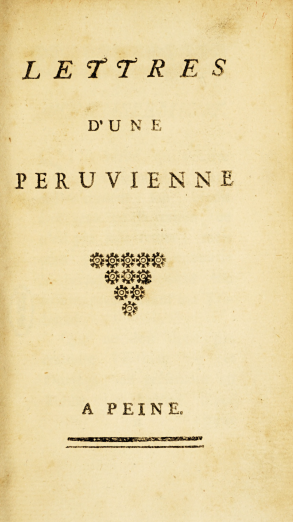
Françoise de Graffigny, Lettres d’une Peruvienne. A Peine [= London: Robert Wilson, 1748]; Françoise de Graffigny, Letters written by a Peruvian princess. London: J. Brindley, 1748.
From Graffigny’s correspondence it is clear that it was not easy to find a publisher for her novel, originally called Zilia. It was eventually published anonymously by the widow of Noel Pissot (active 1727–1752) with the ironic imprint ‘A Peine’ [With Difficulty]. The demand for the novel must have been enormous, because at least nine other pirated editions appeared using the same imprint.
The ‘A Peine’ edition in the JCB was in reality printed in London in 1748. In the same year, an English translation appeared. Pissot only produced one other official reprint, frustrating Graffigny who was barely compensated for her work.
Françoise de Graffigny, Letters of a Peruvian princess, with the sequel. London: Harrison and Co., 1792.
Despite the immediate success, the unique ending on the novel was not universally appreciated. Zilia neither chose her Peruvian lover Aza nor her European savior Déterville, and, in addition, did not accept the primacy of European values by converting to Christianity.
This resulted in a number of male rewriting or additions to the – at this point – still officially anonymous Lettres, giving them a more conventional ending. Ignace Hugary de Lamarche-Courmont published Letters of Aza, or of a Peruvian, Conclusion of the Peruvian Letters (1748). These 35 letters from the perspective of the male protagonist end with the promise of marriage, in this way creating a more traditional ending that redefined. Many later editions include the additional Letters of Aza, as if they belong to the original work.
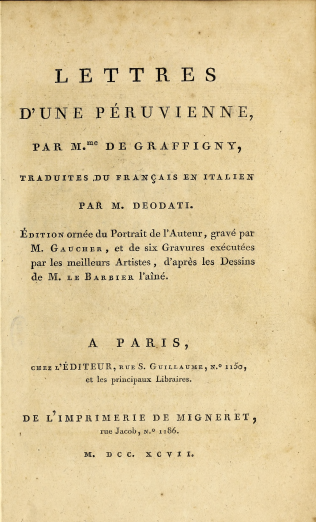
Françoise de Graffigny, Lettres d’une Péruvienne, Paris: Migneret, 1797; Françoise de Graffigny, Lettres d’une Péruvienne. Paris: Briasson, 1782.
Guiseppe Deodati de Tovazzi (born in Turin 1694) gave Italian lessons in Paris and was known for his discussions with Voltaire on the whether Italian or French was the most perfect language. His Italian translation of the Lettres (1759) appeared a year after Graffigny’s death and was published multiple times, both in Italian and in bilingual (Italian/French) editions. It aimed to be a teaching aid for those who wanted to practice Italian.
In a French language 1782 edition, Deodati is even identified as the author of the Lettres. There are however more problems with this edition, since the printer mentioned on the title page died in 1775.
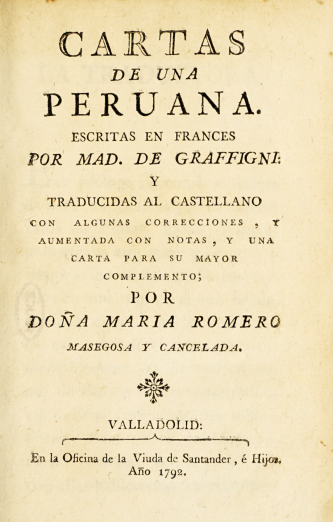
Françoise de Graffigny, Cartas de una peruana. Valladolid: viuda de Santander, é hijos, 1792.
Maria Romero Masegosa y Cancelada is known only for the Spanish translation and serious alteration of Graffigny’s Lettres. She added numerous moralising notes, suppressed critical passages on religion, softens the original negative judgement on the Spanish colonisation and even adds one letter at the end.
In this letter, Zilia does decide to convert to Catholicism and justifies the conquest of Peru by stressing how it improved the wellbeing of the local inhabitants.
Françoise de Graffigny, Letters written by a Peruvian princess. London: J. Robson, [1771].
After the initial success of the first edition of the novel, Graffigny’s name appeared in the privilege of the second edition (1752). But even if she was not named explicitly on the title page, reviewers identified her as the author from the very beginning.
The absence of Graffigny as the official author therefore has to been seen as an expression of expected female modesty. Only after Graffigny’s death did her name feature prominently on the title page of a good number of the editions. Since 1762, some even added a portrait and a biography.
Raynal's work(s)-in-progress
Guillaume-Thomas-François Raynal (1713–1796), also known as Abbé Raynal, was a well-connected journalist and writer in Paris Enlightenment circles. His major work, the Histoire philosophique et politique des établissements et du commerce des Européens dans les deux Indes (1770) is considered one of the first global histories of the commercial age. It represents an often critical history of European colonial trade and settlements, including topics such as slavery, religion, customs and indigeneity. The ban of the work and consequent exile of Raynal only added to its popularity.
The Histoire des deux Indes has an extremely complicated publication history. First, every official re-edition (1774 and 1780) expanded the narrative in an attempt to keep up with recent events. Second, Raynal’s role was that of an editor rather than an author. The Histoire des deux Indes was written by a changing group of anonymous authors and editors, including Baron d’Holbach and Denis Diderot. Lastly, many later editors reworked and extracted those passages that suited their purposes. Because of these eccentricities, it is not easy to define where one Histoire des deux Indes ends and another edition begins.
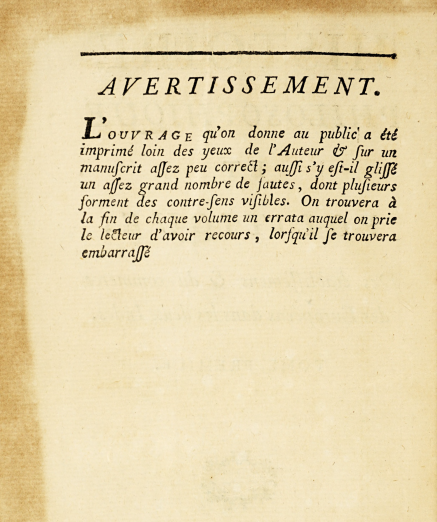
Guillaume-Thomas-François Raynal, Histoire philosophique et politique, des établissemens & du commerce des Européens dans les deux Indes. Amsterdam [= Paris?], 1770.
The first edition of Histoire des deux Indes was published anonymously in six volumes. It bears an Amsterdam imprint but does not mention the printer or the author. The clandestine nature of the work is strengthened by the confession of the publisher that this work was printed far from the eyes of the author and from a poorly edited manuscript, explaining the great number of printing errors.
The note of the editor was another way to mislead the censor, since a typographic analysis of the edition makes it clear that this work is not printed in Amsterdam (likely in Paris). The 14 re-editions of this first iteration of the text that appeared between 1770 and 1774 all mention Amsterdam in the imprint, but are in reality printed in Lyon, Liège, Rouen and Genève.
Guillaume-Thomas-François Raynal, The sentiments of a foreigner, on the disputes of Great-Britain with America. Philadelphia: James Humphreys, 1775.
The earliest translation of Raynal’s work into English was printed in Philadelphia in 1775. It frames the work as the impartial view of an outsider on the conflict between Great Britain and its Thirteen Colonies (allied with France) at the brink of the War of Independence. It only contains chapters 28-33 of book 18 of the second edition (1774). In this passage, Raynal warns against the dangers of possible independence of the colonies.
The printer James Humphreys was publisher of the Pennsylvania Ledger, a newspaper loyal to the British cause. The publication of the text was probably related to Raynal’s admittance to the American Philosophical Society that same year.
Atlas Portatif pour..., Amsterdam: E. van Harrevelt & D. J. Changuion, 1773. / Rigobert Bonne, Atlas de toutes les parties connues..., [Geneva, 1780]. / Guíllaume-Thomas-François Raynal, Histoire philosophique..., Geneve: Jean-Leonard Pellet, 1780.
Already in 1773, the Amsterdam publishers Van Harrevelt and Changuion published a portable atlas (Atlas portatif) of 46 maps to accompany the Histoire des deux Indes. The work was probably undertaken without the collaboration of Raynal, but led the Genevan publishers of the third edition to create an official atlas. The 50 maps were prepared by Rigobert Bonne, one of the leading cartographers of his time, but there is no proof of Raynal’s involvement in the production of the atlas. As was the case with the editions of the actual text, multiple unauthorised editions of the the atlas appeared almost immediately.
The 1780 edition was also the first to include a series of fold-out statistical tables on international trade. Originally added to the 1780 edition, they soon were widely reprinted and sold separately.
Guillaume-Thomas-François Raynal, Histoire philosophique et politique des établissemens et du commerce des Européens dans les deux Indes. Geneve: Jean-Leonard Pellet, 1780.
After an official second version published in The Hague in 1774, Raynal published the third iteration in Genève in 1780. Raynal’s name appeared on the title page, and the work also contained a portrait and a biography. The tone of the work is more bold, in part thanks to the substantial anonymous contributions of Diderot. Apart from this large format quarto edition, the publisher Pellet also offered smaller formats of the text (octavo and duodecimo) for those who wanted a cheaper version.
The book was banned by church and state and publicly burned by the hangman in 1781. Declared an enemy of the state, Raynal was forced to leave France for Prussia, where he stayed the large part of his exile. He was allowed to return to France in 1787, on condition he did not enter Paris.
Guillaume-Thomas-François Raynal,The revolution of America. Philadelphia: Robert Bell, [1782].
The chapters 38 to 52 of the third edition dealing with the now former English colonies were published separately as Révolution de l’Amérique (1781) and translated into English one year later. This enormously popular work was one of the first to use the term revolution in relation to the American-English conflict.
Raynal’s suggestion that American independence was primarily motivated by a refusal to pay taxes, brought him in conflict with Thomas Paine who wrote A Letter Addressed to the Abbe Raynal (1782) emphasizing that the revolution was based on principles of democratic self-government.
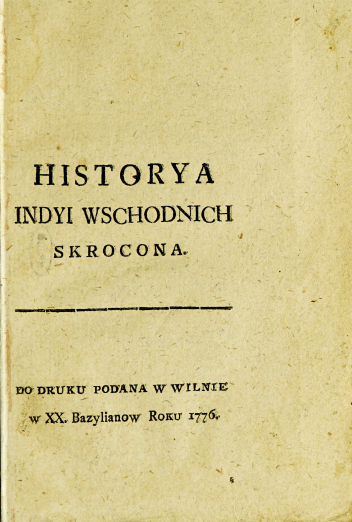
Guillaume-Thomas-François Raynal, Historya Indya Wschodnich Skrocona. Vilnius: Drukarnia Bazylianow, 1776.
The publisher Tadeusz Podlecki belonged to Polish enlightened circles and was the editor of the progressive newspaper Dziennik Handlowy [Commercial Daily] from 1786-1794. Ten years earlier, he published this small format extract of Raynal’s work, based on the 1774 edition. Interestingly, Podlecki decided to omit all of Raynal’s chapters on the West Indies. Perhaps this reflected the contemporary concerns of Polish merchants, who had little connection to the Americas but were more likely to be involved with trade with the Ottoman Empire.
Stedman's visions of Surinam
John Gabriel Stedman’s Narrative of a Five Years’ Expedition Against the Revolted Negroes of Surinam (1796) is a complicated text. Published more than 20 years after the events it recounts, it tells the story of Stedman’s deployment to the Dutch-controlled colony of Surinam to suppress an armed Black revolt in 1772. Against the backdrop of these military exploits, Stedman describes a wide spectrum of colonial society as well as aspects of Surinam’s natural environment, in the tone of a picaresque novel. Stedman often takes on the role of observer and describes many scenes of cruelty related to slavery and military authority. The romanticized relationship with his concubine Joanna, an enslaved mixed race woman and mother of their child Johnny, is one of the principal themes.
Stedman was also a gifted illustrator, and he made numerous drawings that together with his annotations formed the basis of the first edition. The work was reprinted upwards of twenty-five times in six languages across Europe and North America. The original 80 engravings were seldom fully reproduced in later works; instead, they were selected, transformed or even completely omitted depending on how Stedman’s text was interpreted and marketed.
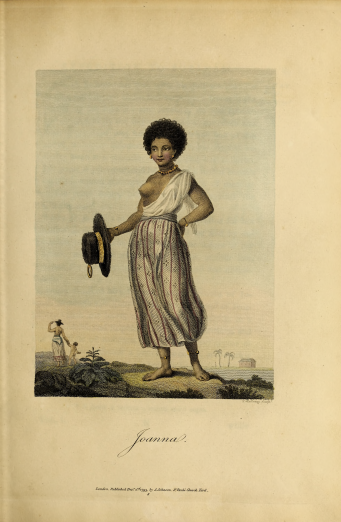
John Gabriel Stedman, Narrative, of a five years’ expedition, against the revolted Negroes of Surinam.London: J. Johnson, 1796.
Stedman started working on his manuscript based on his diaries in 1778, deleting many of the everyday scenes of commercial sex with enslaved women. In 1790, he presented the finished manuscript to the London printer Joseph Johnson, known for his books that supported the rights of slaves, Jews, women, prisoners and other oppressed members of society. The text was further sanitized by Johnson, much to the dismay of Stedman.
Johnson engaged some of the leading engravers of his time such as Francesco Bartolozzi and William Blake, who interpreted Stedman’s drawings to create the 80 plates that feature in the work. Stedman’s descriptions and visualisations of torture scenes are chilling and horrifying. These scenes are alternated with illustrations of military tactics, local fauna and flora, and (stereotypical) portraits of Surinam inhabitants.
John Gabriel Stedman, Nachrichten von Suriname, dem letzten Aufruhr der dortigen Negersclaven und ihrer Bezwingung in den Jahren 1772 bis 1777. Hamburg: Benjamin Gotttlob [sic] Hoffman, 1797.
The German translation of Stedman’s Narrative appears one year after the first edition as part of a multivolume series of travelogues. The editor Christian Wilhelm Jakobs wanted to adapt the text to a German audience and cut out most of the descriptions and engravings on natural history because he judged them to taken from literature rather than Stedman’s own experience. Similarly, Jakobs also edited out the passages and depictions of atrocities committed against the enslaved in order to “accommodate the delicate feelings of the readers.”
John Gabriel Stedman, Reisen in Surinam, für die Jugend bearbeitet von M. Chr. Schulz. Berlin: In der Schüppelschen Buchhandlung, [1799?].
Stedman’s Narrative was tempered further in this adaptation by Christian Schulz, who published several children’s books based on existing travelogues (James Cook and Jean-François de La Pérouse). Schulz completely rewrites the work into an accessible description of Surinam: its history, geography, fauna and flora. The actual description of Stedman’s journey only begins on p. 72 of 180.
The five plates accompanying the work combine several themes of the original illustrations. The famous image of Stedman’s concubine Joanna is paired with a maroon figure, originally from another plate, with a beach and palm trees as a backdrop. The vignettes in the background (the house and Joanna with child), are removed. This way, Joanna is racially segregated away from the “civilised white” world.
John Gabriel Stedman, Voyage à Surinam et dans l’intérieur de la Guiane..., Paris: F. Buisson, 1798.
In this French 1798 edition, Stedman’s text is framed as a source text on the Dutch colony of Surinam: a model and point of comparison for the neighboring French colony of Guiana. The military aspect of Stedman’s travels is omitted from the title, and more than 200 pages of information on Guiana are added at the end of the text, written by a certain Lescaillier as an answer to Stedman’s findings on natural history.
An interesting commercial decision was the presentation of the 44 plates in a separate larger tome. It is a selection of copies of the original English edition, showing not only maps and estate plans, but also natural history and some of visualisations of corporal punishment.
Birmingham Ladies’ Society for the Relief of Negro Slaves, Album. [Birmingham, Eng., 1828].
In the 19th century, Stedman’s Narrative was rediscovered as a source for the abolitionist cause. Much attention went to the relationship between Stedman and Joanna which was seen as an example of the triumph of love over social taboos.
The Birmingham Ladies’ Society for the Relief of Negro Slaves included excerpts of Stedman in the albums the women put together in order to state their case. They contained various texts both in manuscript and print and were given or borrowed to possible supporters of the suppression of slavery. The brief excerpt in manuscript in this 1828 Album describes the flagellation of an 18-year- old enslaved woman (see illustration in 7.1).
Related Events
There are no events to display currently. Please check back soon.
There are no events to display currently. Please check back soon.
Credits
Exhibition prepared by Stijn van Rossem.